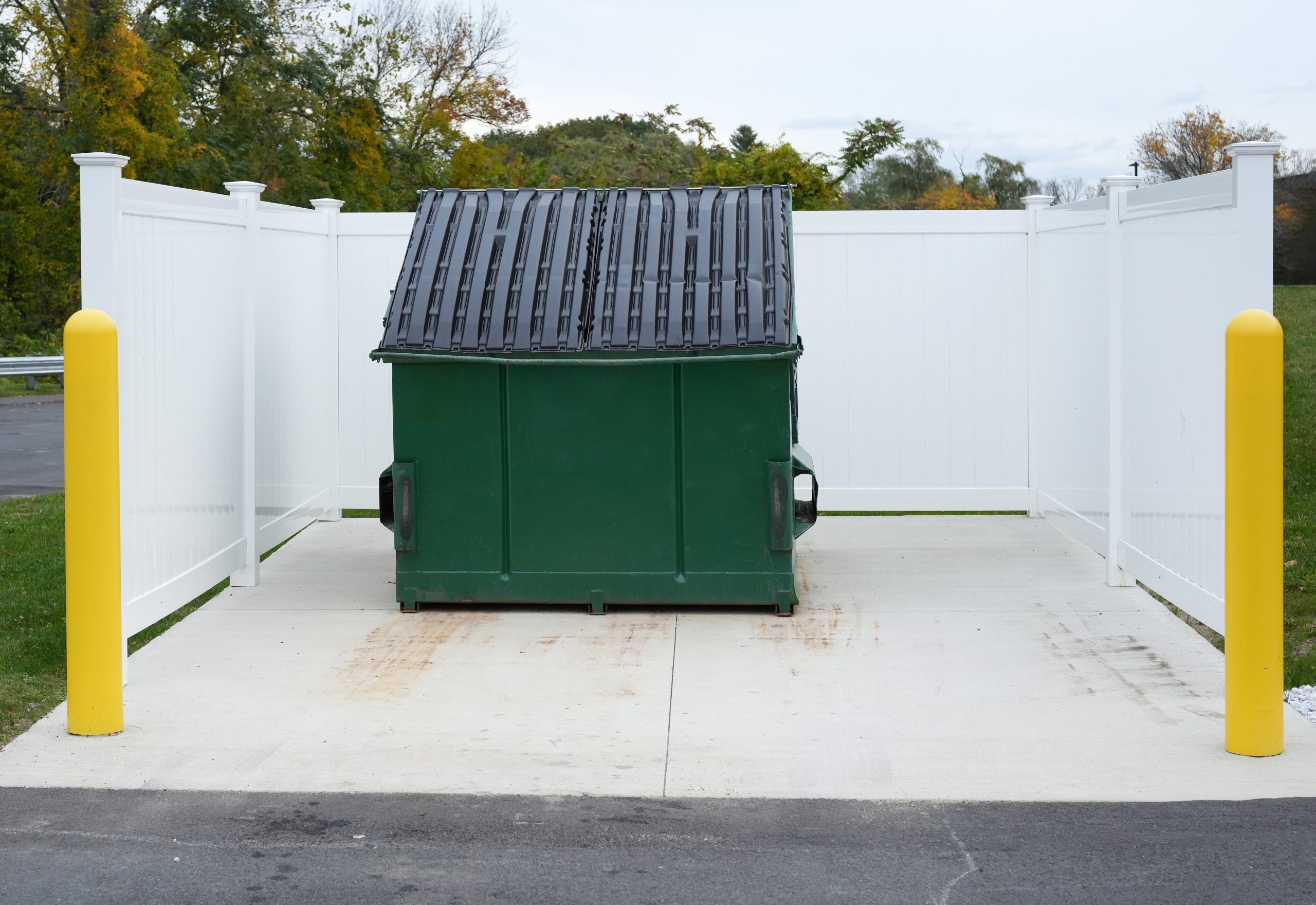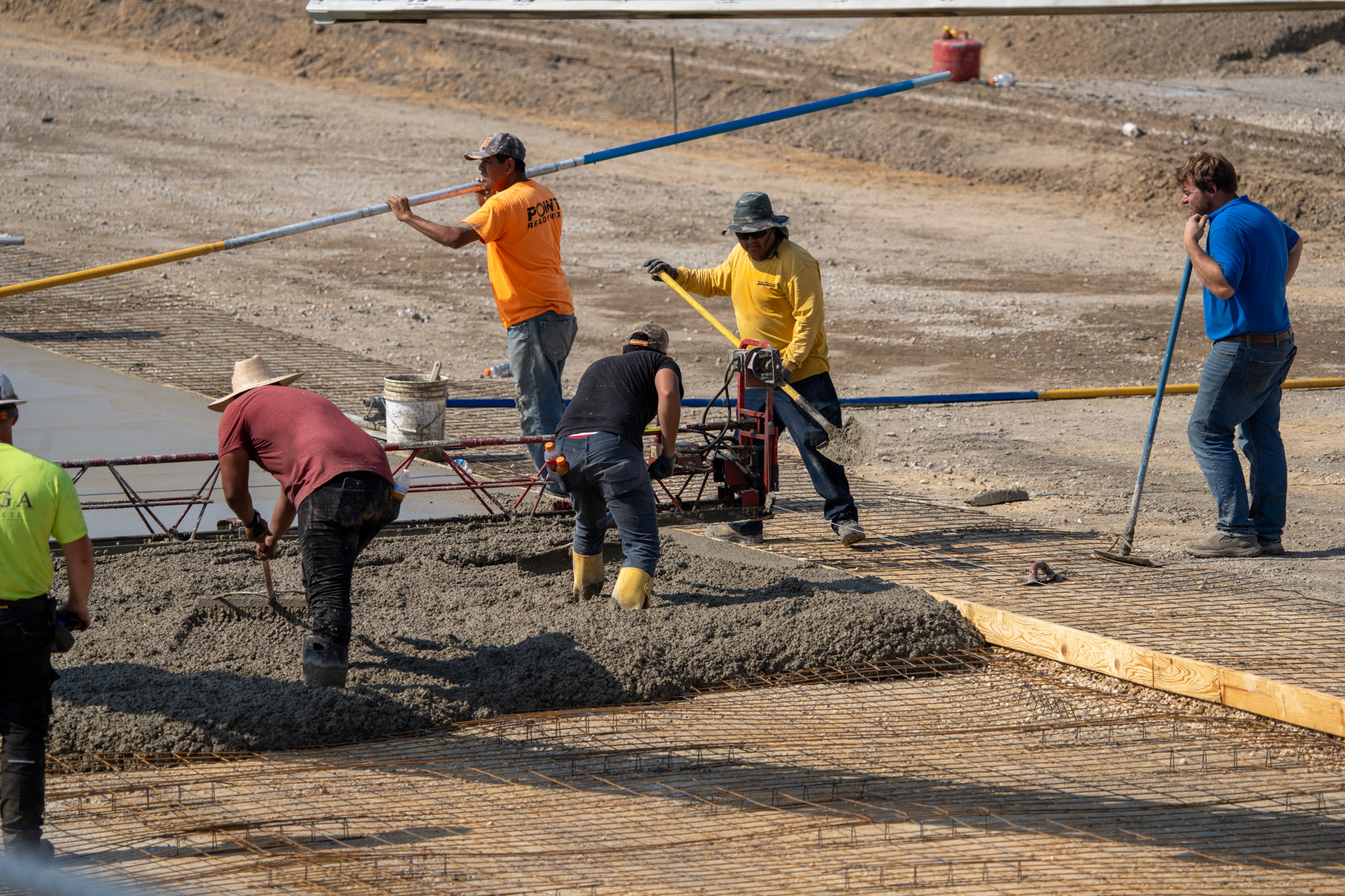Dumpster pad design: concrete vs asphalt and how to stop rutting

Dumpster pad design explained: compare concrete vs asphalt, stop rutting, and prevent damage. Learn pros, cons, costs, and best practices so you can start planning now.
Why dumpster pads fail and how rutting starts
A dumpster pad takes the toughest abuse on any commercial site. Refuse trucks weigh tens of thousands of pounds, they turn slowly, and they often pause with the rear axles grinding against the surface. Add freeze-thaw cycles, water infiltration, and dripping oil or leachate, and it is no surprise that rutting and cracking show up fast. Rutting is permanent deformation of the surface and base. It begins when the subgrade is weak, the base is too thin, the asphalt mix is too soft for high temperatures and slow turns, or the concrete is under-reinforced and poorly jointed. In Wisconsin, freeze-thaw action can lift poorly drained areas and break them down when water freezes under or inside the pavement. Good dumpster pad design prevents these problems by matching the material, thickness, mix, and base to the loads on site.
Concrete vs asphalt: which dumpster pad material is best
Concrete dumpster pad: strengths, limits, and ideal uses
Concrete is often the first choice for a dumpster pad because it resists static loads, hot tire scuffing, and oil better than typical asphalt. It does not rut under slow, heavy turning like softer asphalt can. A well designed concrete pad includes the right thickness, reinforcement, and jointing to control cracking. In cold climates, air-entrained concrete improves freeze-thaw durability.
- Pros: Excellent rut resistance, good chemical and oil resistance, long service life, bright surface for visibility and cleanliness, low maintenance when joints are sealed.
- Cons: Higher initial cost than most asphalt options, needs proper curing time before heavy use, can crack if joints and reinforcement are not designed correctly, repairs are more specialized.
- Typical specs for heavy-duty use: 8 to 10 inches thick, 4000 to 5000 psi air-entrained concrete, #4 rebar at 12 inches on center each way, doweled joints at the interface with adjacent pavement, 2 percent cross slope for drainage, broom finish for traction, sealed joints to keep water and debris out.
Asphalt dumpster pad: strengths, limits, and ideal uses
Asphalt can perform well for dumpster pads when engineered for heavy loads. The key is using a stiff, rut-resistant mix, adequate thickness, and a strong base. Standard parking lot asphalt often fails under refuse truck wheels, but heavy-duty mixes with polymer-modified binders and larger stone sizes perform much better.
- Pros: Lower upfront cost than concrete in many cases, quicker to open to traffic, easier to resurface, blends seamlessly with asphalt parking lots.
- Cons: Sensitive to heat and slow turning loads if the mix is not engineered, more prone to rutting without a thick base, vulnerable to oil and leachate if not maintained.
- Typical specs for heavy-duty use: 6 to 8 inches of hot mix asphalt in two or three lifts over 8 to 12 inches of well compacted crushed stone base, polymer-modified binder, 19 mm binder course with a 12.5 mm surface course, or stone matrix asphalt for high shear areas. Plan for a stiffer binder grade and tight density control during compaction.
Hybrid approach: concrete pad with asphalt approach
On many commercial sites, the best solution is a hybrid. Use concrete for the dumpster pad and immediate loading area, then connect it to the rest of the asphalt parking lot with a heavy-duty asphalt approach. This gives you rut resistance where the truck turns and sits, while keeping costs lower for the rest of the drive path. Asphalt Contractors often recommends this strategy for new builds and reconstructions where refuse trucks follow a predictable path into a gated enclosure.
Design for heavy refuse truck loads
Refuse trucks can exceed 60,000 to 80,000 pounds when fully loaded. The rear tandem axles carry a large share of that weight while turning and braking near the dumpster pad. Your design needs to handle HS-20 or higher load ratings, and account for repeated daily or weekly loading.
- Concrete pad design: 8 to 10 inches thick, 4000 to 5000 psi, air-entrained, with continuous rebar. Saw-cut joints at 10 to 12 feet spacing, dowels at transitions, and isolation joints at enclosure posts, curbs, or buildings.
- Asphalt pad design: 8 to 12 inches of crushed stone base compacted to 95 percent of standard Proctor density, topped with a total of 6 to 8 inches of heavy-duty asphalt in two or three lifts. Use polymer-modified binder. Consider stone matrix asphalt for the top lift in the turning zone.
- Approach apron: Extend the heavy-duty section 20 to 30 feet in front of the dumpster. This is where turning and braking stresses are greatest.
- Turning radius: Provide adequate turning room so trucks do not scrub tires in tight circles. Reduced scrubbing reduces surface shear and rutting.
Subgrade and base preparation: the foundation that stops rutting
No surface can last if the base is weak. Rutting often starts in the base or subgrade when water softens fine soils or when compaction is inadequate. Proper preparation protects your investment.
- Soil evaluation: Identify clay, silt, or organics. Remove unsuitable material and proof roll to find soft spots. Stabilize weak areas with additional stone, geogrid, or cement stabilization as needed.
- Separation fabric: A woven geotextile between subgrade and base can prevent fines from pumping into the base and can improve load distribution.
- Crushed stone base: Use well graded, angular stone. In Southeast Wisconsin, 1 1/4 inch crushed limestone is common. Compact in lifts, keep it dry and stable, and verify density.
- Thickened base at the pad: Add 2 to 4 inches of extra base thickness directly under the heavy-duty area.
- Edge restraint: Prevent edge failures by thickening the edge or using curbs. For asphalt pads, consider a concrete perimeter beam or apron at the leading edge to resist shoving.
Drainage, freeze-thaw, and cold climate details
Water is the enemy of pavement. In Wisconsin, freeze-thaw damage happens when trapped water expands in cold weather. A dumpster pad needs positive drainage, sealed joints, and good subsurface management.
- Surface slope: Aim for 2 percent slope away from the enclosure and buildings. Avoid flat spots where leachate or rainwater can pond.
- Subsurface drainage: Where soils are tight, consider a perforated underdrain at the low side of the pad tied to a storm structure. This keeps the base dry.
- Joint sealing: For concrete, seal joints with a suitable sealant to keep water out. For asphalt, seal the interface where asphalt meets concrete to prevent infiltration at the joint.
- Snow and ice care: Use proper deicing materials. Avoid piling snow directly against the enclosure where meltwater will refreeze on the pad.
Preventing rutting: proven strategies that work
- Use the right material in the right place. Concrete at the pad and turning zone is the most rut-resistant choice. If using asphalt, specify a rut-resistant, polymer-modified mix and adequate thickness.
- Increase base thickness and quality. A thicker, well compacted crushed stone base spreads loads and resists deformation.
- Control water. Design for surface runoff and consider underdrains on tight soils. Seal joints and edges to block infiltration.
- Upgrade the asphalt mix. Choose a stiffer binder grade, larger aggregate, and a dense, low permeability gradation. Stone matrix asphalt is excellent for high shear zones.
- Improve truck maneuvering. Provide wider approaches and proper angles so drivers do not need to grind tires in one spot.
- Protect the surface. Install steel angles or wear plates at dumpster wheel contact points inside enclosures. Use bollards to prevent impacts that break edges.
- Maintain early and often. Crack seal, patch small ruts immediately, and clean oil spills. Fast action prevents larger failures.
Construction best practices
- Survey and layout. Mark pad boundaries, approach, and enclosure posts. Confirm elevations for positive drainage.
- Excavate and proof roll. Remove soft material and undercut as needed. Stabilize weak areas with geogrid or additional stone.
- Place and compact base. Install the crushed stone base in lifts. Verify density and cross slope.
- Form and reinforce concrete or place asphalt lifts. For concrete, set forms, place reinforcement, and pour in a single continuous operation. For asphalt, place binder and surface lifts with proper temperature and compaction.
- Jointing and transitions. Saw cut concrete joints within 12 to 24 hours. Dowel the concrete to concrete transitions. Seal the asphalt to concrete joint with hot-pour sealant.
- Curing and opening to traffic. Concrete typically needs 7 days before heavy truck loads, longer in cool weather. Asphalt can often be opened within 24 to 48 hours, depending on temperature and lift thickness.
- Punch list and protection. Install bollards, wheel stops, and door guards. Stripe and add signage as needed.
Costs and budgeting in Southeast Wisconsin
Costs vary by site conditions, thickness, and material choices. In Southeast Wisconsin, a heavy-duty concrete dumpster pad typically ranges from about 10 to 18 dollars per square foot. A heavy-duty asphalt pad with an upgraded base often ranges from about 6 to 12 dollars per square foot. Sites with poor soils, tight access, or extensive drainage work may cost more. A hybrid approach with a concrete pad and asphalt approach often provides the best value.
- Key cost drivers: Subgrade condition, base thickness, concrete or asphalt thickness, polymer-modified mixes, underdrains, enclosure details, access and staging, and winter construction conditions.
- Life cycle view: Concrete often has a higher upfront cost but lower long-term maintenance. Heavy-duty asphalt can cost less initially and be resurfaced later. The best choice depends on use, budget, and maintenance plan.
Maintenance plan for long service life
- Quarterly inspection: Look for early rutting, cracks, joint failures, or ponding. Fix small issues fast.
- Cleaning: Remove oil, grease, and food waste that can soften asphalt and stain concrete.
- Crack sealing: Seal asphalt cracks annually or as needed. Reseal concrete joints when needed.
- Surface treatments: Sealcoating can help adjacent parking areas, but avoid heavy sealcoat build-up on the primary turning zone. Use high quality materials if sealing near the pad.
- Patching: Mill and inlay rutted asphalt areas with a rut-resistant mix. For concrete spalls, use proper repair mortars and restore joint function.
Dumpster enclosure details that extend life
- Bollards and guards: Place bollards to protect gates and corners. Add steel angles at door edges.
- Wheel stops or curb edges: Keep trucks from backing too far and breaking slab edges.
- Steel wear plates: Consider plates at the dumpster wheel contact zone inside the enclosure.
- Slope and trench drains: A small trench drain at the low side can move water away quickly if allowed by local codes.
- Lighting and signage: Clear lines of sight and instructions help drivers position without excessive turning.
Permits, codes, and site logistics
Local municipalities often require permits for new pads, enclosure changes, or drainage tie-ins. Work with an experienced contractor who understands local code, stormwater rules, and snow storage needs. In Wisconsin, details like air-entrained concrete, cold weather concreting procedures, and frost depth for posts and curbs matter. Plan construction sequencing to maintain trash service during the work, either with temporary containers or adjusted pickup schedules.
Why choose Asphalt Contractors Inc. for your dumpster pad
Asphalt Contractors Inc., established in 1979 and based in Union Grove, Wisconsin, has more than four decades of experience building durable dumpster pads for commercial properties. We are a full-service paving contractor that designs and builds asphalt and concrete solutions, including heavy-duty pads, approaches, and enclosures. Because Asphalt Contractors manufactures its own asphalt, we control mix quality and can provide polymer-modified and rut-resistant designs tailored to your site. Our crews use top-tier equipment, certified practices, and careful quality control to deliver long lasting results. We serve Southeast Wisconsin, including Racine, Kenosha, Walworth, Waukesha, and Milwaukee counties, and we stand behind our work with responsive maintenance support. When you need a dumpster pad that resists rutting, we bring the expertise to plan it right and build it right.
How to start your dumpster pad project
- Schedule a site visit. Asphalt Contractors will evaluate your subgrade, drainage, access, and enclosure needs.
- Choose materials. Decide on concrete, heavy-duty asphalt, or a hybrid based on your budget and service life goals.
- Finalize design. We set thickness, reinforcement, mixes, joints, and drainage details that match refuse truck loads.
- Plan logistics. Coordinate pickup schedules, temporary containers, and safe work zones.
- Build and verify. Our team constructs the base and surface, then completes final checks so you can put the pad into service with confidence.
Frequently asked questions
How thick should a concrete dumpster pad be
For most commercial sites with heavy refuse trucks, 8 to 10 inches of air-entrained concrete is recommended. Use 4000 to 5000 psi concrete with #4 rebar at 12 inches on center. Include saw-cut joints at 10 to 12 feet spacing and dowels at transitions. In very heavy or high-frequency service, consider 10 to 12 inches.
Can asphalt work for a dumpster pad without rutting
Yes, if it is engineered correctly. Use 8 to 12 inches of compacted crushed stone base and 6 to 8 inches of heavy-duty hot mix asphalt with a polymer-modified binder. Consider stone matrix asphalt for the top lift in the turning zone. Also, extend the heavy-duty section 20 to 30 feet in front of the dumpster where trucks turn and brake.
How do I stop oil and leachate from damaging the pad
Design for drainage so liquids do not pond, clean spills promptly, and use sealed joints. For asphalt, consider a fuel resistant surface treatment in the high-impact zone, and maintain it as needed. For concrete, proper curing and a penetrating sealer can improve stain resistance.
How long before a new pad can handle refuse truck loads
Concrete usually needs 7 days before heavy trucks can use it, and it reaches full design strength at 28 days. Accelerated mixes can shorten that timeline. Asphalt can usually be opened within 24 to 48 hours, depending on weather and lift thickness. Your Asphalt Contractors project manager will provide site-specific guidance.
Should I sealcoat a dumpster pad
Sealcoat helps parking lots, but it can scuff in high-shear areas like a dumpster pad. If you choose to seal, use high quality materials and expect more frequent touch-ups. Many owners leave the concrete pad unsealed or use a penetrating sealer and rely on heavy-duty asphalt mixes for adjacent approaches.
Final thoughts
A durable dumpster pad starts with a clear understanding of loads, soils, and climate. Choose the right material for the job, build on a strong base, control water, and detail the enclosure for protection. Whether you prefer the long-term stability of concrete, a value-driven heavy-duty asphalt section, or a hybrid design, Asphalt Contractors has the expertise and in-house resources to deliver a pad that stands up to daily refuse service. Ready to stop rutting and prevent damage at your property in Southeast Wisconsin? Contact Asphalt Contractors today to plan, price, and build a dumpster pad that works.


